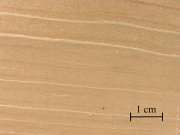Difference between revisions of "Engelmann spruce"
Jump to navigation
Jump to search
(username removed) |
(username removed) |
||
| Line 8: | Line 8: | ||
== Synonyms and Related Terms == | == Synonyms and Related Terms == | ||
| − | ''Picea engelmannii''; | + | ''Picea engelmannii''; épicéa d'Engelmann (Fr.); épinette (Fr.) |
{| class="wikitable" | {| class="wikitable" | ||
| Line 20: | Line 20: | ||
* ''Dictionary of Building Preservation'', Ward Bucher, ed., John Wiley & Sons, Inc., New York City, 1996 | * ''Dictionary of Building Preservation'', Ward Bucher, ed., John Wiley & Sons, Inc., New York City, 1996 | ||
| − | * | + | * Random House, ''Webster's Encyclopedic Unabridged Dictionary of the English Language'', Grammercy Book, New York, 1997 |
| − | * | + | * External source or communication Comment: Western Pine Association, Portland Oregon: air-dry weight = 27 pcf |
[[Category:Materials database]] | [[Category:Materials database]] | ||
Revision as of 06:40, 24 July 2013
Description
A soft, light wood obtained from the Engelmann spruce, Picea engelmannii, native to the western part of North America. The yellowish to reddish fine-grain wood is used for lumber, millwork, construction, and the manufacture of paper and boxes.
Synonyms and Related Terms
Picea engelmannii; épicéa d'Engelmann (Fr.); épinette (Fr.)
| Density | 27 pcf |
|---|
Authority
- Dictionary of Building Preservation, Ward Bucher, ed., John Wiley & Sons, Inc., New York City, 1996
- Random House, Webster's Encyclopedic Unabridged Dictionary of the English Language, Grammercy Book, New York, 1997
- External source or communication Comment: Western Pine Association, Portland Oregon: air-dry weight = 27 pcf
